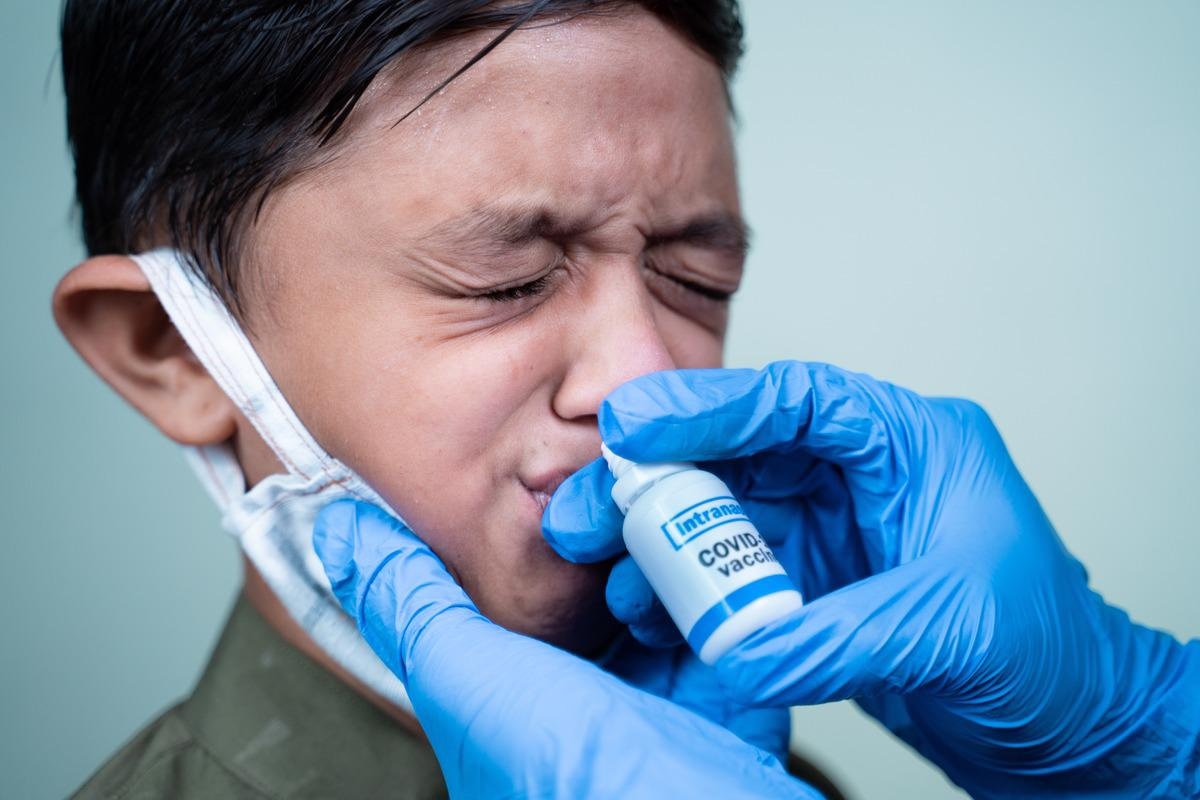In a recent study posted to the bioRxiv* preprint server, researchers determined immunity afforded by a severe acute respiratory syndrome coronavirus 2 (SARS-CoV-2) nasal vaccine prospect, sCPD9.

Background
Vaccines are a crucial part of the SARS-CoV-2 pandemic response. As of early 2022, 10 Coronavirus disease 2019 (COVID-19) vaccines meet the standards for safety, effectiveness, and quality of the World Health Organization (WHO)'s emergency use listing (EUL). Currently licensed COVID-19 vaccines are based on the inactivated virus, subunit vaccines, nucleoside-modified messenger ribonucleic acid (mRNA) vaccines, and adenoviral vectors.
However, despite the initial long-term protection against severe disease and high vaccination efficiency of the available COVID-19 vaccines, their ability to protect against infection and symptomatic illness diminishes gradually, especially after the emergence and spread of the SARS-CoV-2 Omicron variant. Furthermore, worldwide vaccination disparities remain disturbingly high. These conditions and the ongoing evolution of SARS-CoV-2 necessitate a more robust COVID-19 vaccine and vaccination approach.
Additionally, COVID-19 vaccinations that are currently licensed are delivered intramuscularly and can effectively produce systemic immunity. On the other hand, these vaccinations are less effective at generating long-lasting mucosal immunoglobulin G (IgG) and IgA responses and tissue-resident memory (Trm) cell responses in the lungs.
About the study
In the current research, the scientists compared preclinical effectiveness and immune reactions to the COVID-19 mRNA BNT162b2 vaccine, the live attenuated virus vaccine prospect sCPD9, and an adenovirus-vectored spike (S) vaccine following single/double vaccination in Syrian hamsters. The team compared distinct strategies of vaccination and assessed possible variations in mucosal and systemic immunity imparted by various vaccines and different prime-boost vaccine schedules that consisted of systemic priming coupled with a respiratory boost.
The vaccinated Syrian hamsters were challenged with the SARS-CoV-2 Delta variant to assess the vaccine-imparted protection. In addition, the study employed single-cell sequencing to determine the adaptive and innate immune responses to virulent SARS-CoV-2 infection and vaccination.
Syrian hamsters were immunized with either one dose, i.e., prime-only test, or two doses, i.e., prime-boost experiment, using the three vaccines investigated. The COVID-19 vaccine candidate sCPD9 was administered intranasally, and the mRNA or adenovirus type 2 (Ad2-S) vaccines were given intramuscularly.
Hamsters were infected with Delta via nasal route three weeks following vaccination in the prime-only test. In the prime-boost study, hamsters were boosted using a second vaccine dose three weeks after the priming shot. Further, two weeks following booster dosing, hamsters were nasally infected with the Delta variant. The hamsters were euthanized on days 2 and 5 following the viral challenge, and blood and sections of the lower and upper airways were taken for viral titrations, quantitative reverse transcription-polymerase chain reaction (RT-qPCR), single-cell sequencing, and histological investigations.
Results
The study results demonstrated that the modified live attenuated SARS-CoV-2 vaccine candidate, sCPD9, conferred higher protection from COVID-19, particularly at the mucosal viral entry points, compared to the two other evaluated vaccines. Importantly, anti-SARS-CoV-2 IgA in the nasal mucosa of hamsters vaccinated with sCPD9 was considerably higher. Heterologous vaccination with an intramuscular mRNA vaccine succeeded by an intranasal sCPD9 boost dose increased COVID-19 immunity.
In contrast to the other cohorts, sCPD9-vaccinated animals had considerably greater protection from tissue damage, lung inflammation, and viral replication. In a prime-only context, the effects of sCPD9 immunization were the greatest across all relevant parameters. Likewise, double sCPD9 vaccination outperformed mRNA-sCPD9 vaccination, double mRNA vaccination, and two-dose adenovirus vaccination in a prime-boost environment. Besides, sCPD9-vaccinated animals had lower stimulated pro-inflammatory gene expression pathways, the primary cause of SARS-CoV-2 infection pathogenesis. In sCPD9-vaccinated hamsters, neuronal cells in the nasal mucosa had lower transcriptional activity.
In addition, the authors discovered many gene expression profiles linked to adaptive immune memory activation in sCPD9-vaccinated animals. They found increased pre-plasmablasts produced from memory B cells and T cell proliferation, indicating fast memory cell activation, in the blood of Delta-challenged hamsters. Furthermore, according to an examination of local pulmonary immune responses, sCPD9-vaccinated hamsters' lungs had considerably more proliferating T cells. A subset of those proliferating T cells had a tissue-resident memory (Trm)-restricted characteristic and was connected to the recognized Trm cluster.
Conclusions
According to the authors, this was the first study illustrating a preclinical inter-platform SARS-CoV-2 vaccine comparison that consisted of a live attenuated vaccine.
The study findings showed that all regimens comprising the live-attenuated COVID-19 vaccine candidate, sCPD9, outperformed the other analyzed SARS-CoV-2 vaccines in terms of effectiveness. The heterologous vaccination regimens encompassing sCPD9 imparted strong immunity against COVID-19. sCPD9 vaccination, combined with COVID-19 mRNA/AD2 vaccines or alone, led to fast differentiation of pre-plasmablasts, diminished tissue damage, robust mucosal and systemic humoral responses, faster recall of memory T cells from lung tissue, and rapid viral clearance.
Collectively, the present study suggested that live-attenuated SARS-CoV-2 vaccinations may have advantages over existing vaccines, particularly when used as a booster, and might offer a strategy for COVID-19 pandemic management.
*Important notice
bioRxiv publishes preliminary scientific reports that are not peer-reviewed and, therefore, should not be regarded as conclusive, guide clinical practice/health-related behavior, or treated as established information.
- Geraldine Nouailles, et al. (2022). A live attenuated vaccine confers superior mucosal and systemic immunity to SARS-CoV-2 variants. bioRxiv. doi: https://doi.org/10.1101/2022.05.16.492138 https://www.biorxiv.org/content/10.1101/2022.05.16.492138v1
Posted in: Medical Science News | Medical Research News | Disease/Infection News
Tags: Adenovirus, Blood, Cell, Cell Proliferation, Coronavirus, Coronavirus Disease COVID-19, covid-19, Efficacy, Evolution, Gene, Gene Expression, immunity, Immunization, Immunoglobulin, Inflammation, Lungs, Nucleoside, Omicron, Pandemic, Polymerase, Polymerase Chain Reaction, Preclinical, Proliferation, Research, Respiratory, Ribonucleic Acid, SARS, SARS-CoV-2, Severe Acute Respiratory, Severe Acute Respiratory Syndrome, Syndrome, Transcription, Vaccine, Virus

Written by
Shanet Susan Alex
Shanet Susan Alex, a medical writer, based in Kerala, India, is a Doctor of Pharmacy graduate from Kerala University of Health Sciences. Her academic background is in clinical pharmacy and research, and she is passionate about medical writing. Shanet has published papers in the International Journal of Medical Science and Current Research (IJMSCR), the International Journal of Pharmacy (IJP), and the International Journal of Medical Science and Applied Research (IJMSAR). Apart from work, she enjoys listening to music and watching movies.
Source: Read Full Article
